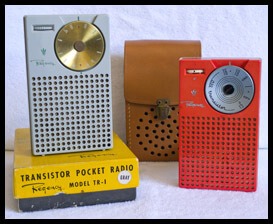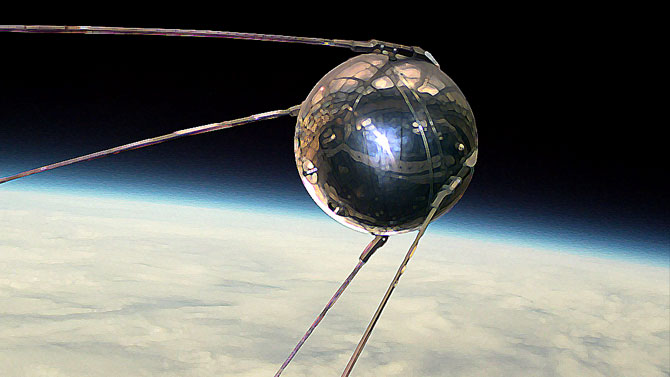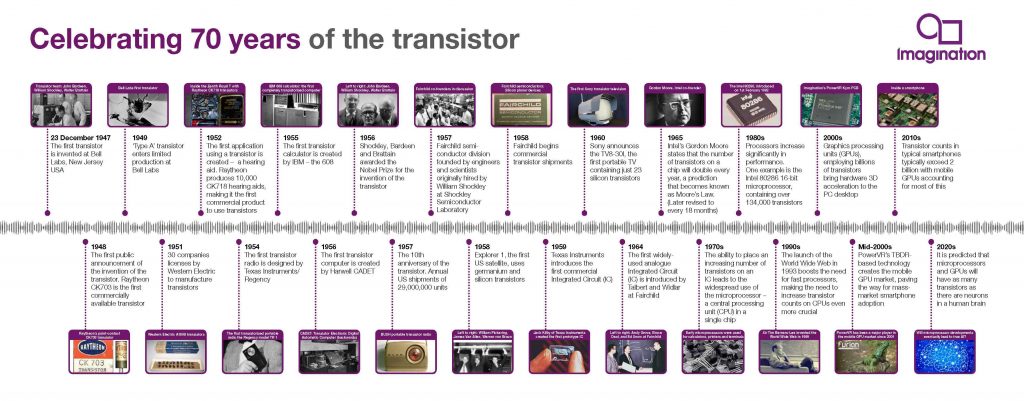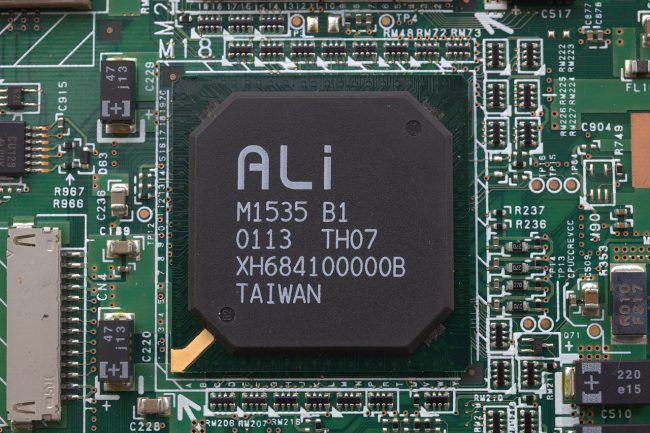- 21 December 2017
- Imagination Technologies
Transistors are the unsung hero of the internet age yet few people outside the semiconductor industry are aware they exist. The first transistor was invented at Bell Labs, New Jersey, USA on 16 December 1947 by William Shockley (seated below at Brattain’s laboratory bench), John Bardeen (left) and Walter Brattain (right). This was perhaps the most important electronics event of the 20th century, as it later made possible the integrated circuit (IC) and microprocessor that are the basis of modern electronics. Prior to the transistor the only alternative to its current regulation and switching functions was the vacuum tube (thermionic valve), which could only be miniaturized to a certain extent and wasted a lot of energy in the form of heat.
The world’s first transistor (1947)
First shown to the world on 23 December 1947, no one really knew what to do with the invention and it was only when engineers started to appreciate that it would enable products to be built smaller, more reliably and with less power consumption that it moved from a laboratory curiosity to its first application – a hearing aid built by the US firm Sonotone in December 1952.

Partly because this was both a niche and a small market, the established electronics companies, such as RCA, Sylvania and Philco, remained slow to take the transistor bait and this reluctance opened the door for a joint collaboration between Regency, the proprietary product division of IDEA, an independent contract electronic equipment manufacturer, and Texas Instruments (TI), an up and coming transistor developer. By combining Regency’s vision and radio expertise with TI’s technology and strong financial backing, the world’s first transistor radio, the Regency TR-1, was launched in December 1955.
Transistor Impact
Portable and pocket-sized, the Regency TR-1 was the smallest and most affordable radio that the world had ever seen and it triggered a worldwide demand for small and portable electronic products. This is the first device that bred the DNA for today’s personal electronics.
The world’s first transistor radio – the Regency TR-1 (1955)

The timing was also right from a social point of view. In 1954, Bill Haley’s ‘Rock Around the Clock’ hit the charts, along with Elvis Presley’s first record, ‘That’s All Right Mama’. With music now in their pocket, teenagers could listen out of earshot of their disapproving parents, something the inventors had not anticipated nor were pleased about! When Regency co-founder John Pies’ children became teenagers, it was common to hear “turn that music down” barked in the Pies household, whilst Walter Brattain, one of the transistor co-inventors, often lamented that his only regret was that it stimulated rock and roll.
Possibly the radio’s most important social contribution was that it opened the floodgates of global information, decades before the information age became vogue. Its small size, battery operation and portability enabled people who had previously been denied access to outside information to have front row seats in external affairs.
The Japanese company, Tokyo Tsushin Kogyo (Totsuko) also recognised the transistor radio’s potential and entered the market in 1956 with a competitive device that quickly became the company’s first big product success, leading to its eventual global consumer electronics domination. Its 1957 follow-up product, under the company name now changed to Sony ‘so Americans could pronounce it’, was marketed as “the shirt pocket size smallest transistorized radio in the world”, saw the firm equip all their salesmen with oversized pocket shirts.
The importance of the TR-1 was especially clear to Thomas J. Watson, Jr., head of IBM, who used it to goad his reluctant engineers to embrace the new technology to build computers with transistors. It was another event, however, that proved the tipping point for computers, namely the Soviet Union’s launch of the world’s first satellite (Sputnik 1) on 4 October 1957. Determined to catch up and surpass Soviet technology, the US government turned to the semiconductor industry to build the control and guidance computers of sufficient complexity that would fit into a rocket of practical size and weight.
The launch of Sputnik by the USSR in 1957 spurred the USA to turn to the semiconductor industry to help them compete in the space race

Industry Repercussions
The first electronic products were made from individual transistors, but before long engineers learnt how to integrate several simultaneously, giving birth to the first integrated circuit (IC) in 1957. Industry development thereafter followed a predominantly evolutionary process with the number of transistors on an IC increasing exponentially each year, a process known as Moore’s Law after one of the semiconductor industry’s key founding fathers.
Built predominantly on silicon (sand), IC production technology successfully combined several branches of science, including physics, chemistry, mechanics, mathematics and computer sciences, to build products of ever-increasing complexity.
The TR-1 had four transistors; a 1971 microprocessor had 2,300 transistors; the 1978 Intel 8086 had 29,000 transistors; the 2003 Intel Pentium 4 55 million transistors and the latest Intel Skylake Xeons microprocessors 7.2 billion transistors. The latest desktops have over 10 billion each, whilst Samsung and Micron’s most advanced memory devices weigh in at 40 billion transistors.
A typical smartphone, such as this Meizo Pro 7 Plus featuring a PowerVR Series 7XTP GPU, contains around 100 billion transistors.
A cutting-edge smartphone containing Imagination’s PowerVR GPU IP will now contain around 100 billion transistors; were this made out of individual transistors it would be 60 football pitches in size and cost US$150 billion. If the same advances had been applied to, for example, the airline industry, a commercial flight between New York and London costing around US$900 and taking seven hours in 1978 would today cost less than a cent and take under one second. Not bad for an industry built on sand.
So silicon industry – happy 70th birthday!
Malcolm Penn
Founder and CEO of Future Horizons: the global semiconductor industry analysts

Follow Imagination Technologies on social media on Twitter @ImaginationTech.





